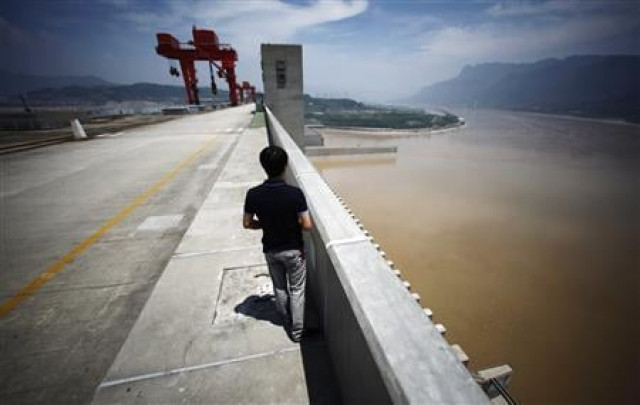Thousands being moved from China's Three Gorges - again
China relocated 1.3 million people during the 17 years it took to complete the Three Gorges dam.

It's a reminder of the social and environmental challenges that have dogged the world's largest hydroelectric project. While there has been little protest among residents who will be relocated a second time, the environmental fallout over other big investments in China has become a hot-button issue ahead of a leadership transition this year.
In some cases, protests have forced the scrapping of multi-billion dollar projects. The most recent was on July 28, when Chinese officials cancelled an industrial waste pipeline after anti-pollution demonstrators occupied a government office in the eastern city of Qidong, destroying computers and overturning cars.
"If the government says you have to move, you move," said Shuai Linxiang, a 57-year-old woman among 20,000 people to be relocated from Huangtupo, where they were resettled in 1998. "We can’t oppose them."
The Three Gorges dam was completed in July when its final turbine joined the national grid and the facility reached its full capacity of 22.5 gigawatts, more than enough to power Pakistan or Switzerland.
As the dam was being built on the Yangtze River, in central Hubei province, authorities moved 1.3 million people who lived in what became its 1,045 sq km (405 sq mile) reservoir, an area greater in size than Singapore.
Reuters was recently given a rare tour of the 181-metre (600-ft) tall dam and reservoir. In a sign of how sensitive the fresh relocations are, plainclothes security men and people who identified themselves as officials from the "news department” followed Reuters reporters around the area for three days, hindering interviews by intimidating locals with their presence.
Since word of the new resettlement has filtered out, Shuai and her neighbours have become known in China as "Three Gorges’ immigrants, once again".
They were moved to Huangtupo in the late 1990s and early 2000s, when the reservoir began to consume their original town.
Besides 20,000 people in Huangtupo, another 100,000 may be moved in the next three to five years because of geological risks, Liu Yuan, an official with the Ministry of Land and Resources in Beijing said in April, according to state-run China National Radio.
The number of "geological hazards" had risen 70 percent since water levels in the reservoir reached a maximum of 175 metres (574 ft), he said, without elaborating, although he was believed to be referring to landslides. Liu could not be reached for comment.
Landslides in Huangtupo had been exacerbated by changes in water levels in the reservoir, said Fan Xiao, a geologist for a government-linked institute in southwestern Sichuan province, who studied conditions there in 2006.
Dam officials lower water levels by as much as 30 metres during the summer in anticipation of floods, and raise them in winter. The change softens the slopes along its banks, Fan said.
"It's like a person who's standing in place, if you push and pull him, he'll definitely not be as stable as before," he said.
For hundreds of thousands who live on the banks, landslides can wipe out homes. The government has not given recent statistics of deaths from landslides but at least 48 people were killed in 2007 across the area, according to state media.
Three Gorges officials defend the facility and say it has brought development to an otherwise poor region.
Wang Hai, deputy head of the operations department at the complex, said the dam did not increase the risk of landslides, which he said were not unusual along reservoir banks.
"The stability of the reservoir banks is not worse than before," he told Reuters in an interview.
Besides forced resettlement, the dam has been criticised for its polluted waters. Hundreds of factories, mines and waste dumps were submerged over the years and additional urban growth along the reservoir has caused waste water discharge to double between 2000 and 2005, according to International Rivers, a California-based NGO that aims to protect rivers.
An island of waste was floating in the dam's brown waters when Reuters visited.
"After the Three Gorges dam was built, the deterioration of the water quality is very obvious and it is irreversible," said Ai Nanshan, a professor of environmental sciences at Sichuan University. "The water flow has slowed down, so its ability to purify itself has deteriorated."
The dam has accelerated development along the reservoir by 50 to 100 years, said Chen Lei, another official in the Three Gorges operations department.
"If not for the Three Gorges project, their (residents') lives would be confined as before, deep in the mountains, a relatively backward state of poverty," he said.
Reconstruction
Authorities are building a new town nearby called Shennongxi to house residents of Huangtupo.
Shuai was among the first to move to one of the many seven-storey apartment blocks painted in cream, pink and grey colours that stand amid scorched red earth. If you don't move, we won't care about you; she said a local official told her last year.
For income, Shuai sells groceries from her apartment. She was given 5,000 yuan ($790) as a "reward" for being among the first to move, according to a June 2011 government document she showed Reuters; 200 yuan per person in her family and 1,000 yuan in "moving fees".
Officials did not respond to repeated requests for comment on the forced relocation and compensation given to residents.
The local government will offer a new apartment and cash as compensation for resettlement, it said in a December 2009 document explaining the scheme, without providing details of the amounts.
It will only compensate residents according to the floor area of their previous apartments, but will not pay extra if the apartment in Shennongxi is bigger than their previous homes.
Residents who "reject the relocation or delay relocating" or “make unreasonable demands for compensation again" after being compensated will receive a warning, the local government said.
Shuai reckons 30 households have moved to Shennongxi. Her grandson, who attends school in the town, lives away from his entire family because there's virtually no transport.
"By moving here, we have no way to survive," she said.
In Huangtupo, many residents await the order to resettle.
"The (first) time when we moved, our home, our land, our fruit trees, they were all finished, they were all drowned by the water," said Li Huanggui, 94, sitting in her home in the only apartment block left standing amid demolished buildings.
A shop owner, surnamed Qing, has been told she has to move in the second half of the year. She relocated the first time in 2000 when water from the reservoir flooded her home.
Asked if she thought the government would compensate her this time, she scoffed.
"The more we move, the poorer we get," she said.



















COMMENTS
Comments are moderated and generally will be posted if they are on-topic and not abusive.
For more information, please see our Comments FAQ